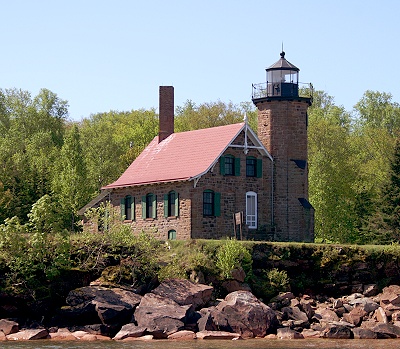Lighthouses of the Apostle Islands
Part Three
Back to Part Two
Although the light stations were built to lessen the chances that
shipwrecks would occur, the hazards of navigation on Lake Superior
resulted in numerous occasions when keepers would take an even more active
role in aiding distressed mariners. At times, their actions were nothing
short of heroic. In 1885, the steamer Prussia caught fire on the
open lake off the tip of Sand Island. Lighthouse keeper Charles Lederle
rowed a small boat several miles out to the burning vessel and single-handedly
rescued the entire crew.

Sand
Island Lighthouse |
What may have been the worst day in the history of the Apostle Islands
began at Sand Island only a few months after Ella Luick departed. Early
on a stormy morning in September 1905, Emmanuel Luick heard a distress
signal from a vessel close to shore. He climbed the lighthouse tower in
time to watch the steamer Sevona break in two as it struck a hidden
shoal. Passengers and crew tried frantically to reach shore on lifeboats
and improvised rafts. Seventeen survived, but Luick was helpless to aid
seven who perished.
Meanwhile, a similar tragedy was unfolding elsewhere in the archipelago.
Just a few hours after the Sevona foundered, the schooner-barge Pretoria broke apart off Outer Island. Abandoning ship, the crew
of ten nearly reached shore, but were tossed into the water when their
lifeboat capsized. Sixty-one year old keeper John Irvine waded repeatedly
into the surf to pull gasping men to safety; thanks to his efforts, five
survived.
In recent years, advances in technology have made such disasters
rare on the Great Lakes. Progress has brought change to the lighthouses
as well, eliminating the need for resident keepers. In 1921, Sand Island
was the first Apostles light converted to automatic operation, with an
acetylene lamp controlled by a valve that responded to the sun’s warmth.
Organizational shifts brought profound changes, too. The Lighthouse Service
was abolished in 1939, and its functions transferred to the U.S. Coast
Guard. As civilian keepers retired, their places were taken by young Coast
Guardsmen, and the former homes of lighthouse families assumed the air
of military posts.
It took a long time, but one by one the keepers’ dwellings were shuttered
across the archipelago. The last manned station, Devils Island, was automated
in 1978. Left unoccupied in the harsh environment, the buildings inevitably
suffered.
With the establishment of the Apostle Islands National Lakeshore, ownership
of the lighthouses passed to the National Park Service. Coast Guardsmen
still visit the towers once or twice a year to service the solar-powered
lamps, but Park Service employees and volunteers maintain the buildings
and guide visitors around the sites.
Caring for historic lighthouses is a big job, and taxes the park’s resources,
but the agency has made steady progress preserving the sites. Few tasks
have been bigger than the one the N.P.S. tackled in 2002. Engineering
studies showed that erosion of the cliff below the Raspberry Island lighthouse
had begun to present a serious threat to the site. If nothing were done
to halt the process, the building might be lost within as little as ten
years. The Outer Island light faced a comparable, though less immediate,
threat. Plans call for a multi-faceted erosion control strategy, combining
construction of revetments at the base of the cliff and slope stabilization
through the planting of carefully selected vegetation.
The light stations of the Apostle Islands hold many stories from all
the years they’ve guided sailors on the waters of the world’s greatest
lake. It’s encouraging to think that, with the proper care, the lighthouses
will be around to tell their tales for a long time to come.
|